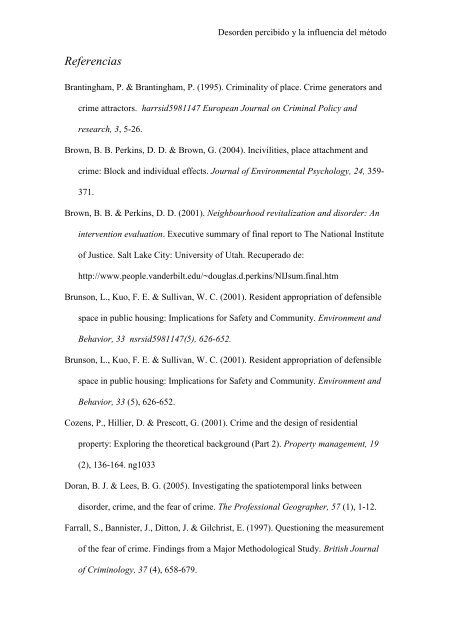Desorden percibido y la influencia del método - University of Surrey
Desorden percibido y la influencia del método - University of Surrey Desorden percibido y la influencia del método - University of Surrey
Conclusiones Desorden percibido y la influencia del método Durante más de 20 años la Teoría de las Ventanas Rotas y otros desarrollos conceptuales han guiado la investigación científica, las políticas sociales y el diseño urbano. Sin embargo, el éxito aparente de este enfoque parece tener más relación con la relativa facilidad con que se pueden instrumentar las políticas y medidas de diseño que con su efectividad para reducir la percepción de inseguridad y el crimen. Los resultados de este estudio sugieren que los indicadores de peligro no son evidentes. Por lo tanto, la creencia de que las características visibles de deterioro y degradación ambiental son muestras de incivilidad social y de peligro es incompleta, ya que tales características por si mismas no presentan peligros. Más bien, la gente interpreta el ambiente en función de quiénes son, de dónde vienen y por qué están ahí (Goffman, 1971; Warr, 1990). La implicación de estos resultados es que no solo distintas personas realizan distintas evaluaciones acerca del desorden y la seguridad, sino que la modificación de las características físicas de los lugares no es suficiente para reducir el crimen y los sentimientos de inseguridad. Mediante la combinación de metodologías cuantitativas y cualitativas para investigar los puntos de vista del público y sus percepciones de desorden, peligro y seguridad, la investigación futura debe también centrarse en la interacción entre factores psicológicos, ambientales y socioculturales, estableciendo el contexto especifico en el que ocurre dicha interacción.
Referencias Desorden percibido y la influencia del método Brantingham, P. & Brantingham, P. (1995). Criminality of place. Crime generators and crime attractors. harrsid5981147 European Journal on Criminal Policy and research, 3, 5-26. Brown, B. B. Perkins, D. D. & Brown, G. (2004). Incivilities, place attachment and crime: Block and individual effects. Journal of Environmental Psychology, 24, 359- 371. Brown, B. B. & Perkins, D. D. (2001). Neighbourhood revitalization and disorder: An intervention evaluation. Executive summary of final report to The National Institute of Justice. Salt Lake City: University of Utah. Recuperado de: http://www.people.vanderbilt.edu/~douglas.d.perkins/NIJsum.final.htm Brunson, L., Kuo, F. E. & Sullivan, W. C. (2001). Resident appropriation of defensible space in public housing: Implications for Safety and Community. Environment and Behavior, 33 nsrsid5981147(5), 626-652. Brunson, L., Kuo, F. E. & Sullivan, W. C. (2001). Resident appropriation of defensible space in public housing: Implications for Safety and Community. Environment and Behavior, 33 (5), 626-652. Cozens, P., Hillier, D. & Prescott, G. (2001). Crime and the design of residential property: Exploring the theoretical background (Part 2). Property management, 19 (2), 136-164. ng1033 Doran, B. J. & Lees, B. G. (2005). Investigating the spatiotemporal links between disorder, crime, and the fear of crime. The Professional Geographer, 57 (1), 1-12. Farrall, S., Bannister, J., Ditton, J. & Gilchrist, E. (1997). Questioning the measurement of the fear of crime. Findings from a Major Methodological Study. British Journal of Criminology, 37 (4), 658-679.
- Page 1 and 2: Desorden percibido y la influencia
- Page 3 and 4: Desorden percibido y la influencia
- Page 5 and 6: Desorden percibido y la influencia
- Page 7 and 8: Figura 1. El Lugar Tal Cual Esta fo
- Page 9 and 10: Desorden percibido y la influencia
- Page 11 and 12: Desorden percibido y la influencia
- Page 13 and 14: Desorden percibido y la influencia
- Page 15 and 16: Desorden percibido y la influencia
- Page 17 and 18: Desorden percibido y la influencia
- Page 19: Desorden percibido y la influencia
- Page 23 and 24: Desorden percibido y la influencia
- Page 25: Desorden percibido y la influencia
Referencias<br />
<strong>Desorden</strong> <strong>percibido</strong> y <strong>la</strong> <strong>influencia</strong> <strong>del</strong> <strong>método</strong><br />
Brantingham, P. & Brantingham, P. (1995). Criminality <strong>of</strong> p<strong>la</strong>ce. Crime generators and<br />
crime attractors. harrsid5981147 European Journal on Criminal Policy and<br />
research, 3, 5-26.<br />
Brown, B. B. Perkins, D. D. & Brown, G. (2004). Incivilities, p<strong>la</strong>ce attachment and<br />
crime: Block and individual effects. Journal <strong>of</strong> Environmental Psychology, 24, 359-<br />
371.<br />
Brown, B. B. & Perkins, D. D. (2001). Neighbourhood revitalization and disorder: An<br />
intervention evaluation. Executive summary <strong>of</strong> final report to The National Institute<br />
<strong>of</strong> Justice. Salt Lake City: <strong>University</strong> <strong>of</strong> Utah. Recuperado de:<br />
http://www.people.vanderbilt.edu/~doug<strong>la</strong>s.d.perkins/NIJsum.final.htm<br />
Brunson, L., Kuo, F. E. & Sullivan, W. C. (2001). Resident appropriation <strong>of</strong> defensible<br />
space in public housing: Implications for Safety and Community. Environment and<br />
Behavior, 33 nsrsid5981147(5), 626-652.<br />
Brunson, L., Kuo, F. E. & Sullivan, W. C. (2001). Resident appropriation <strong>of</strong> defensible<br />
space in public housing: Implications for Safety and Community. Environment and<br />
Behavior, 33 (5), 626-652.<br />
Cozens, P., Hillier, D. & Prescott, G. (2001). Crime and the design <strong>of</strong> residential<br />
property: Exploring the theoretical background (Part 2). Property management, 19<br />
(2), 136-164. ng1033<br />
Doran, B. J. & Lees, B. G. (2005). Investigating the spatiotemporal links between<br />
disorder, crime, and the fear <strong>of</strong> crime. The Pr<strong>of</strong>essional Geographer, 57 (1), 1-12.<br />
Farrall, S., Bannister, J., Ditton, J. & Gilchrist, E. (1997). Questioning the measurement<br />
<strong>of</strong> the fear <strong>of</strong> crime. Findings from a Major Methodological Study. British Journal<br />
<strong>of</strong> Criminology, 37 (4), 658-679.



